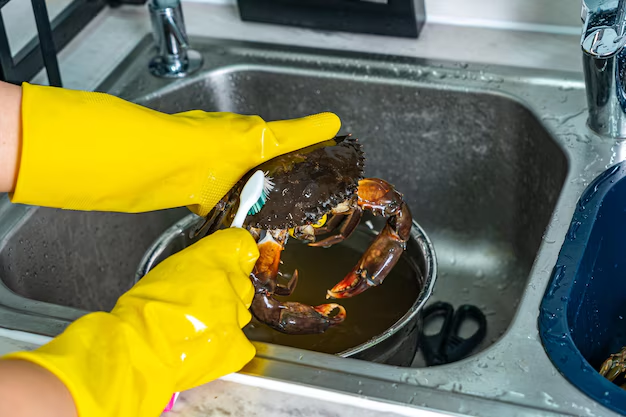Say Goodbye to Rust: Easy and Effective Ways to Remove Rust from Your Refrigerator
Is your refrigerator showing signs of unsightly rust? This common issue can mar the appearance and functionality of your kitchen's centerpiece. Fortunately, tackling rust is manageable with some simple techniques and a bit of elbow grease. Let's explore how to restore your refrigerator to its original shine, delving into practical steps and preventative measures to keep it looking great.
Understanding Why Rust Forms on Refrigerators
Before diving into solutions, it’s essential to understand what causes rust on refrigerators. Rust forms when iron in metal surfaces reacts with oxygen in the presence of moisture. This can happen due to:
- Spills and leaks: Unattended spills or leaks can increase the moisture around your fridge.
- Environmental humidity: High humidity levels can accelerate the rusting process.
- Damaged paint or coating: Scratches or chipped paint expose the metal beneath, making it more susceptible to rust.
With this knowledge in mind, let’s move on to addressing the rust effectively.
Materials Needed for Rust Removal
To successfully remove rust from your refrigerator, you'll need the right tools and materials. These can often be sourced from your local hardware store:
- White vinegar: A natural acid that dissolves rust.
- Baking soda: Acts as a mild abrasive to help scrub away rust.
- Lemon juice: Another acidic option that reacts with rust.
- Sandpaper or a scrubbing pad: For exfoliating the rusted area.
- Clean cloths: Used for wiping and drying.
- Protective gloves: To protect your hands from harsh chemicals or rough surfaces.
- Paint or enamel: To touch up the refrigerator after rust removal.
Step-by-Step Guide to Remove Rust
Tackling rust doesn’t have to be daunting. Here’s a simple and effective guide to removing rust from your fridge:
Step 1: Preparation
- Ensure Safety: Unplug the refrigerator to avoid electrical shocks before beginning any cleaning.
- Clear the Area: Empty the fridge and move it to ensure you can easily access the rusted sections.
Step 2: Cleaning the Surface
- Wipe Down: Use a damp cloth to clean the area around the rust, removing dirt and debris.
- Inspect: Identify the extent of the rust damage. Check for any deep corrosion that may require professional attention.
Step 3: Apply Natural Acid
- Vinegar Method: Saturate a cloth with white vinegar and lay it over the rust spots. Let it sit for 30 minutes to an hour to allow the vinegar to break down the rust.
- Scrub Gently: Use a scrubbing pad or sandpaper to gently remove the rust. Repeat as necessary until the rust loosens.
- Lemon Alternative: If using lemon juice, mix with some baking soda to create a paste and apply it to the rust. Allow it to sit and then scrub off.
Step 4: Rinse and Dry
- Clean Off Residue: Wipe down the treated area with a damp cloth to remove residual rust and acid.
- Dry Completely: Use a clean cloth to thoroughly dry the surface, preventing further rust due to moisture.
Step 5: Final Touches
- Smooth the Surface: Sand down any rough areas left by rust removal for an even finish.
- Repaint: Apply touch-up paint or enamel to protect the area and restore appearance.
Preventative Measures to Avoid Future Rust
Preventing future rust is as important as removing existing rust. Here are some practical tips to keep your refrigerator rust-free:
- Regular Cleaning: Establish a routine cleaning schedule to keep surfaces dry and remove spills promptly.
- Use Dehumidifiers: In high humidity areas, use dehumidifiers to control moisture levels.
- Protective Coatings: Apply rust-protectant sprays or waxes to reinforce the surface barrier.
- Ventilation: Ensure your kitchen is well-ventilated to keep humidity at bay.
Quick Tips for Managing Rust 🛠️
- Act Fast: Address rust as soon as you notice it to prevent it from spreading.
- Avoid Harsh Chemicals: Stick to natural acids like vinegar and lemon juice to minimize damage to coating.
- Consistent Maintenance: Regularly check for wear and tear needing attention before rust sets in.
Common Rust-Related Questions
Can rust cause functional issues in a refrigerator?
While surface rust usually doesn’t affect function initially, extensive rust can compromise structural integrity, affecting seals or hinges, potentially leading to efficiency losses over time.
What if homemade methods aren't working?
For severe rust, professional treatment might be necessary. This could involve more intensive sanding, rust inhibitors, or even part replacement.
Is it possible to completely rust-proof a refrigerator?
Achieving absolute rust-proofing is challenging, but combining preventative measures like regular application of protective coatings and maintaining a moisture-controlled environment significantly reduces risk.
Conclusion
Rust on your refrigerator doesn’t have to mean replacing your appliance or dealing with an eyesore in your kitchen. By understanding the causes of rust and using household remedies, you can effectively remove rust and keep your refrigerator looking fresh. Regular maintenance and awareness are your best defenses against rust, ensuring your appliance remains an enduring part of your kitchen.
Armed with these strategies, you’re ready to tackle rust and protect your investment. It’s time to give your refrigerator the care it deserves, keeping it pristine and functional for years to come.
